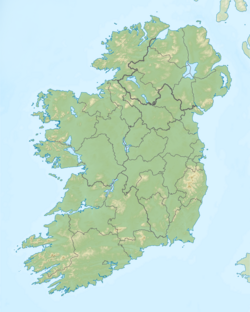Book of Ballymote
| Book of Ballymote | |
|---|---|
| Royal Irish Academy | |
 | |
| Also known as | Leabhar Bhaile an Mhóta |
| Date | 1390–91 |
| Place of origin | Ballymote |
| Language(s) | Middle Irish, with some Latin |
| Scribe(s) | Solamh Ó Droma, Roibéard Mac Síthigh, Maghnus Ó Duibheannáin |
| Patron | Tomaltagh McDonagh |
| Material | Vellum |
| Size | 40cm x 26cm |
| Format | Folio |
| Condition | Imperfect |
| Script | Irish minuscule |
| Contents | genealogy, history, hagiography |
The Book of Ballymote (Template:Lang-ga, RIA MS 23 P 12, 275 foll.), was written in 1390 or 1391 in or near the town of Ballymote, now in County Sligo, but then in the tuath of Corann.
Production and history
It was produced by the scribes Solamh Ó Droma, Roibéard Mac Síthigh, and Maghnus Ó Duibheannáin, on commission by Tomaltagh McDonagh, in the possession of whose clan the manuscript remained until 1522, when it was purchased by Aodh Óg Ó Domhnaill, prince of Tír Conaill, for 140 milch cows. In 1620 it was given to Trinity College, Dublin. It was given on loan to the Revd Anthony Raymond, a former Fellow and vicar of Trim in 1719 or 1720, to be used in research he was doing on the work of Geoffrey Keating and he allowed other scholars access to it. When Raymond died in 1726, the book was retained by Tadhg Ó Neachtain for some years, probably until his death in the early 1750s. He copied extensively from it. It was never returned to the College, but was given to the Royal Irish Academy upon its foundation in 1785 by Chevalier O'Gorman who allegedly purchased it from a millwright's widow in Drogheda for 20 pounds.
Description
The first page of the work contains a drawing of Noah's Ark. The first written page is lost, and the second page describes the ages of the world. After this follows
- a description of the History of the Lost Israelites and the migration from Israel into Europe and their descendants becoming the Gaels and Anglo-Saxon people (see British Israelism). (2r)
- a life of Saint Patrick (6r)
- a copy of the Lebor Gabála Érenn (8r)
- Tecosca Cormaic "The Instructions of King Cormac" and other stories concerning king Cormac mac Airt
- Triads of Ireland
- stories of Fionn Mac Cumhail and Brian Borumh
- various genealogies of clans and kings
- Christian kings of Ulster (34v)
- Christian kings of Leinster (35v)
- Christian kings of Connaught (37v)
- of the Munster families (97r)
- Dál gCais (102v)
- rules of the different measures of Irish versification (157r)
- the only known copy of the Auraicept na n-Éces, or "scholars' primer"(169r)
- the Lebor na gCeart (Book of Rights) (181r)
The book ends with various Greek and Latin fragments on the fall of Troy, including a fragment of the Aeneid.
Editions
- Robert Atkinson. NY: AMS Press. ISBN 0-404-17535-X
- O'Donovan, The Book of Rights, ed. and trans. 1847.
- The Book of Ballymote: Photographic facsimile with introduction by R. Atkinson, (Dublin 1887).
References
- McDonagh, James, History of Ballymote and the Parish of Emlaghfad (1998). [1]
- Harrison, A.: 'Leabhar Bhaile an Mhóta ag tús an 18ú aois', Éigse 23 (1989), 147-50.
- Ó Concheanainn, T.: 'The Book of Ballymote', Celtica 14 (1981), 15-25.
External links
- Royal Irish Academy description
- The Book of Ballymote (excerpt of McDonagh 1998)
- Genealogies from the Book of Ballymote
- Leabhar Bhaile an Mhóta (ria.ie)
- Leabhar Bhaile an Mhóta
- Irish Script on Screen has digital images of the document. Select "Collections", then select "Royal Irish Academy", then scroll down to MS 23 P 12, The Book of Ballymote.

